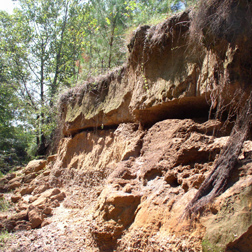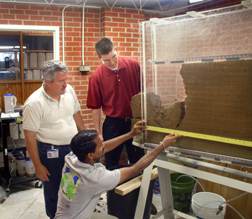Studying Streambanks Reveals
Their Weaknesses and Strengths
|
|
When some experts study bank failures, they aren’t scrutinizing the books of badly run financial institutions. Instead, they’re occasionally wading through Mississippi’s sediment-laden waterways to develop dynamic models of erosion processes and streambank collapse.
“The problem is that the primary source of sediment in many Mississippi streams and rivers is from streambank failure, not from field runoff,” says Agricultural Research Service hydrologist Glenn Wilson, who works at the ARS Watershed Physical Processes Research Unit in Oxford, Mississippi. “Up to 80 to 90 percent of sediment in these streams can be due to bank collapse.”
The sedimentation of streams, rivers, and other waterways is a global concern, and the U.S. Environmental Protection Agency lists sediment as the most common pollutant of U.S. rivers, streams, lakes, and reservoirs. Trapped sediment can reduce the useful lifespan of dams and reservoirs, exacerbate flooding, harm aquatic plants and animals, and transport other pollutants downstream. So over the years, billions of dollars have been spent on streambank protection and restoration efforts to stem erosion and reduce sedimentation loads.
Even though the sediment in streams and rivers is often attributed to erosion and runoff from farm fields, Wilson turned his investigations to the contributions of streambank erosion. He teamed up with Oklahoma State University scientist Garey Fox to study how seepage—the lateral movement of water through the ground—could prompt conditions that led to bank failure.
Wading Through the Data
The researchers started their project with a field survey of streambanks that were severely undercut and prone to collapse. “This type of undercutting has historically been attributed to streamflow,” Wilson says. “Others have noted that during high-flow events, the increased speed and volume of the streamflow cuts into the bank and weakens it. Then when the water level drops, the bank fails.”
But Wilson and Fox found examples of undercut bank failures that had occurred in low-flow streams. When they took a closer look at these banks, they saw evidence that seepage out of streambanks was eroding out layers of soil. The eroded soil layers washed down the face of the streambank and into the stream itself, adding to the sediment load in the stream and leaving the bank weakened and vulnerable to collapse due to having undercuts from the washed-out layers.
“When we were first looking at this, bank stability models didn’t account for subsurface flow—just for surface water flow,” Wilson explains. “So our existing streambank models were actually missing key mechanisms in bank failure.”
The scientists gathered enough field data on seepage erosion processes to develop lab models and refine their understanding of how seepage could exacerbate eventual streambank failure. In the lab, they could control bank depth and seepage flow rates—and they could safely observe the sometimes-sudden collapse of a massive wall of dirt.
“Streambanks can be 10 to 20 feet high, and the subsurface seeps can form at any depth,” Wilson says. “We couldn’t measure peak seepage rates in the field under all the conditions we’d like because it was just too dangerous—the banks collapse during storms, and sometimes they’re deep enough to bury you.”
Wilson and Fox confirmed for the first time that a stable streambank can quickly become unstable when seepage erosion is added to the mix of factors that promote bank failure. The probability of failure reached 100 percent when the degree of undercutting reached about 30 to 50 millimeters (1 to 2 inches) into the bank face. The researchers concluded that streambank failure may stem as much—or more—from the effect of seepage erosion undercutting the streambanks as from the added weight of the waterlogged soil as seepage increases.
Wilson included their calculations into the Bank Stability and Toe Erosion Model, a program developed at the ARS National Sedimentation Laboratory that calculates the likelihood of streambank failure for new or existing banks and simulates the efficacy of different approaches for protecting the streambank from erosion. “Our big payoff for this research has been recognizing and understanding the seepage erosion process and how it contributes to bank failure,” Wilson says. “Looking back, I’d say the biggest surprise from this work is that the role of seepage had been overlooked for so long.”
Putting Green Stuff in the Bank
Down the hall, ARS geologist Natasha Bankhead has also been studying streambanks, but she’s focusing on how removing mature plants can weaken the structures—and how adding young riparian plants can support them. “Plant roots reinforce the soil in the same way that rebar can be used to reinforce concrete,” Bankhead says.
Plants vary in their effectiveness as streambank sentinels. Grasses have thin, dense roots that form an underground net and can protect the soil on shallow banks from eroding. Taller banks need more substantial reinforcement, but trees don’t always fit the bill.
“Trees don’t have much of an impact on bank stability until they’re around 7 to 10 years old,” Bankhead says.
As part of her research, Bankhead is testing the tensile strength of roots—the force required to pull a root to the point where it breaks—of different tree species. Her studies indicate that in the southeastern United States, willows and other primary succession trees growing along streambanks have lower tensile strength levels. Trees that are part of the later successional stages, like sycamores, river birches, oaks, and cottonwoods, have higher tensile strengths. But the root structures don’t just provide physical support.
“In the summer, trees remove a huge amount of moisture from soil through evapotranspiration,” Bankhead explains. “And bank stability increases as soil moisture decreases, so in the summer, the effect from evapotranspiration actually provides more structural support to the streambanks than the roots do.”
Bankhead has used her findings to develop a program called “RIPROOT,” which models the effects of riparian vegetation on streambank stability. She is collaborating with other researchers to test it in watersheds across the country.
“We’ve made a lot of advances in understanding these processes and incorporating them into mechanistic, process-based models,” Wilson says. “But we need to continue collaborations with soil scientists, geotechnical engineers, hydraulic engineers, and hydrologists to fully understand and integrate subsurface-flow and soil-erosion processes.”—By Ann Perry, Agricultural Research Service Information Staff.
This research is part of Water Availability and Watershed Management, an ARS national program (#211) described at www.nps.ars.usda.gov.
Glenn V. Wilson and Natasha L. Bankhead are in the USDA-ARS Watershed Physical Processes Research Unit, 598 McElroy Dr., Oxford, MS 38655; (662) 232-2927 [Wilson], (662) 281-5712 [Bankhead].
"Studying Streambanks Reveals Their Weaknesses and Strengths" was published in the February 2011 issue of Agricultural Research magazine.









